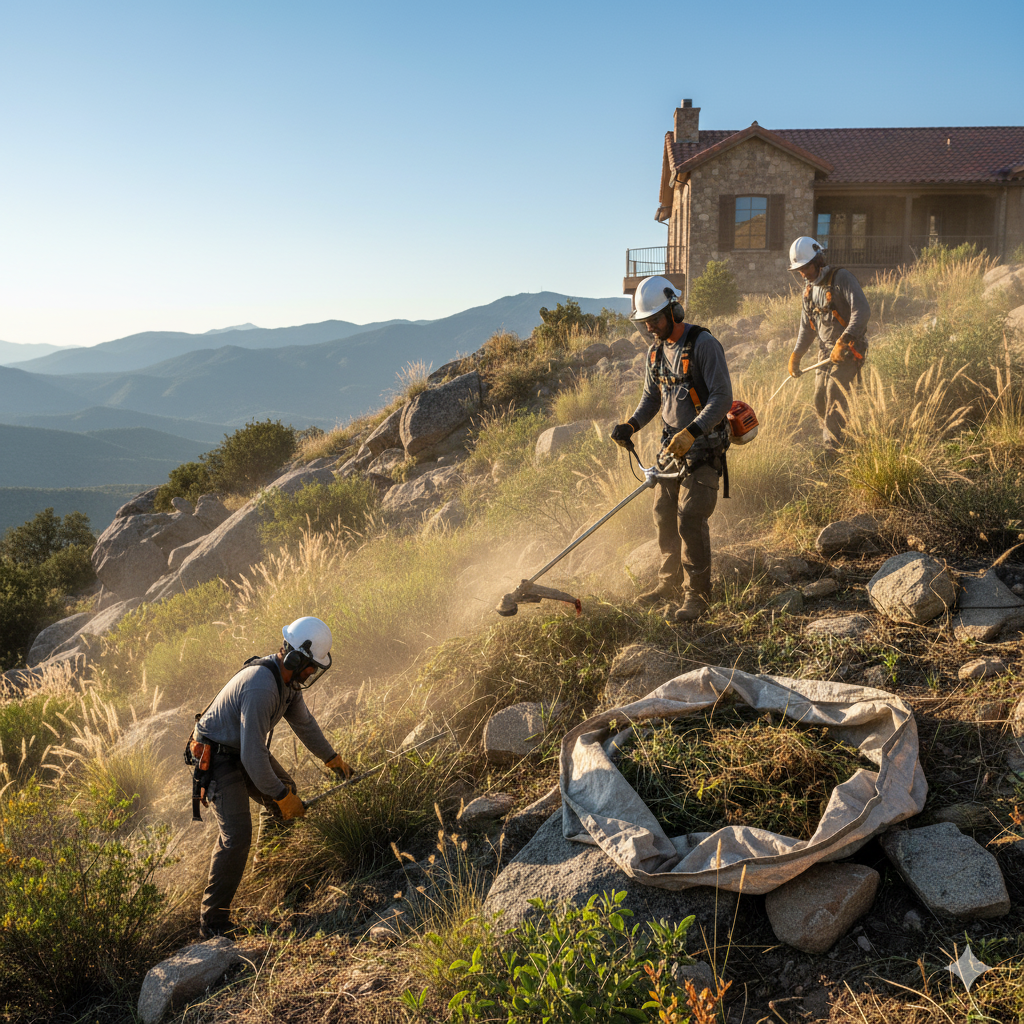
How to Clear Weeds on Slopes and Rocky Areas
Share
Introduction: Weed Abatement Isn’t Always Flat and Easy
In regions like Big Bear and other mountain communities, many properties sit on steep slopes, rocky ground, or uneven terrain — making weed abatement a serious challenge.
These areas are also among the most fire-prone zones, where dry weeds and brush can quickly become fuel for wildfires.
To maintain safety and meet fire code compliance, property owners must find smart, safe ways to clear weeds — even in hard-to-reach places.
1. Understanding the Terrain: Why Slope and Rock Matter
Slopes and rocky soils influence how vegetation grows — and how easily it can be removed.
- Steep slopes make mechanical mowing dangerous or impossible.
- Rocky areas can dull or damage cutting tools.
-
Limited access may prevent large equipment from reaching problem zones.
Each landscape requires a customized approach combining manual techniques, specialized tools, and erosion-safe practices to ensure effective weed control without damaging the environment.
2. Safe Techniques for Steep Slopes
When working on inclines, safety is the top priority. Professionals use methods designed to reduce risk while maintaining control.
Effective Strategies Include:
- String trimmers or brush cutters with shoulder harnesses for better stability.
- Hand-pulling or hoeing on smaller slopes where machinery can’t reach.
- Rope and harness systems for extreme inclines or cliffside properties.
-
Erosion-conscious removal, leaving root structures intact on unstable soils to prevent landslides.
Pro Tip: Always cut vegetation down to 2–4 inches, not bare soil — this helps control regrowth while protecting the slope’s integrity.
3. Working Through Rocky Terrain
Weed abatement on rocky or uneven ground presents its own set of challenges. Standard blades and mower decks often can’t handle the impact.
Recommended Tools & Methods:
- Heavy-duty trimmers with reinforced nylon or steel brush blades.
- Spot-spraying post-emergent herbicides between rocks for precision.
- Manual removal tools such as weed wrenches for deep-rooted species.
-
Mulching or ground cover to suppress regrowth in rocky crevices.
Professionals often use low-impact techniques to avoid scattering stones or damaging irrigation lines hidden beneath the surface.
4. Managing Limited or Hard-to-Reach Access Areas
Mountain and lakefront homes often have areas that can’t be reached by vehicles or large equipment — like narrow pathways, steep driveways, or behind retaining walls.
Solutions for Tough Access:
- Portable, battery-powered tools that minimize noise and emissions.
- Backpack herbicide sprayers for precision treatments.
- Small-scale manual crews rather than heavy machinery.
-
Rope access methods for extreme slopes or canyons.
By combining lightweight equipment with smart logistics, weed abatement crews can clear even the most challenging locations safely and efficiently.
5. Erosion Control After Weed Removal
After clearing weeds on slopes or rocky areas, it’s important to stabilize the soil to prevent erosion or regrowth.
Post-Abatement Tips:
- Apply mulch or straw wattles to secure exposed soil.
- Use erosion-control blankets on steeper hillsides.
-
Seed with native grasses or groundcovers to create natural barriers against new weeds.
This step not only prevents washouts during rain or snowmelt but also promotes healthy, sustainable landscapes.
6. The Importance of Professional Expertise
Attempting DIY weed abatement on rugged terrain can be risky. Professionals have the training, tools, and experience to manage:
- Sloped or unstable soils
- Large rocky outcrops
- Fire compliance regulations
-
Safety protocols for steep environments
Hiring a licensed weed abatement company ensures your property is cleared effectively, remains code-compliant, and minimizes long-term maintenance needs.
Conclusion: Smart Strategies for Mountain and Hillside Properties
Abating weeds on slopes and rocky terrains takes more than effort — it takes strategy, skill, and safety awareness. With the right equipment, erosion-safe methods, and local expertise, you can keep your mountain property clean, compliant, and protected all year long.
Whether you’re in Big Bear, Lake Arrowhead, or the surrounding mountain communities, working with a professional abatement team ensures your home stays safe — no matter how steep or rocky the terrain.
